Digital Solutions Are Not a One-Off Cost
How can a big box retailer better understand customer traffic, product engagement and the impact of content within its laptop display area?
This retailer partnered with a digitally savvy company to identify targeted store performance questions and many focused key performance indicators (KPIs). They then installed 360-degree cameras that tracked relevant customer experience drivers, such as traffic flow, product interactions and dwell time.
Not surprisingly, the resulting data correlated to sales figures.
Ah, but what was driving that data and those sales figures? How much does traffic follow a brand or how much of it is store location? Those and other questions inspired more A/B testing, which pinpointed high-performance locations and reasons for placements that provided poor performance.
That sort of testing and data gathering leads to store optimization, such as giving prime positions to high-margin products. More importantly, it also allows retailers to demonstrate brick & mortar’s value to product vendors and provides new revenue sources, as those vendors pay for data, better product locations and in-store advertising.
Great business intelligence continually provides value
What strategic-thinking retailers understand is that the value here isn’t a one-off testing run. Data should be regularly mined, analyzed and inventoried. It should be used to measure conventional retail wisdom and institutional assumptions and then drive next-generation store design.
Further, the right systems will allow you to remap past data and redraw areas of focus as new questions arise. Your data collection systems also should be capable of scrubbing people from recorded images, thereby ensuring that customers won’t have privacy concerns.
The understanding that digital transformation, from data collection to digital content to app development to hardware & software, is not a one-off or even an occasional cost is a critical part of a long-term strategy for branded environments.
Retail innovation never stops. There is no finish line. The omnichannel convergence within brick-and-mortar spaces is always about keeping up with your customers’ evolving wants, needs and habits, whichever path to purchase they choose.
Crafting the right story benefits shoppers, provides ROI
Just as data gathering and analysis is a continual process, so is digital content development and execution. It needs to be managed, maintained and refreshed. It’s about serving and influencing the customer with the best experience possible, so it’s an investment toward securing their loyalty.
Great content strategies — developed by top-level 2D and 3D animators — educate, entertain and attract customers, while also generating optimized ambiance within your branded environment. Thoughtful UX/UI strategies and well-executed motion graphics ensure the right messages are played at the right time, engaging the right customers.
Targeted digital advertisements pay for themselves. Digital signage investment costs often can be recouped within 12 months or less when they are optimized for content that captures shopper attention. Further, exposure to digital signage can increase the average basket size and inspire impulse purchases. A study of over 3,000 shoppers found that 82 percent of their purchase decisions were made while in a store, 62 percent made an impulse buy while shopping and 16 percent of their unplanned purchases were driven by in-store promotions.
How to use data & insights for optimal brand experiences
When you strategically expand your portfolio of digital solutions, you essentially upgrade every area of the customer experience along the path to purchase, all the while capturing useful business intelligence that informs omnichannel design and execution in the future.
These digital solutions should:
- Attract customers’ attention and reduce shopping friction
- Engage customers with impactful experiences
- Track how marketing campaigns translate into engagement and conversion
- Personalize the customer experience, thereby increasing basket size while cultivating loyalty
- Connect physical and digital touchpoints seamlessly
- Help manage assistance requests & queues, minimizing wait time
- Improve operational efficiency and inventory management
- Enhance associate experience and engagement
- Optimize labor hours management
- Monetize in-store messaging with advertising
- Measure customer behavior as well as the impact of store wayfinding, displays, merchandising and overall design
Those are not static goals, purposes and data points. They continually evolve to meet customers wherever they are.
The good news? When executed strategically, digital solutions that provide actionable business intelligence identify opportunities to better serve your customers, improve our store design and elevate your brand.
